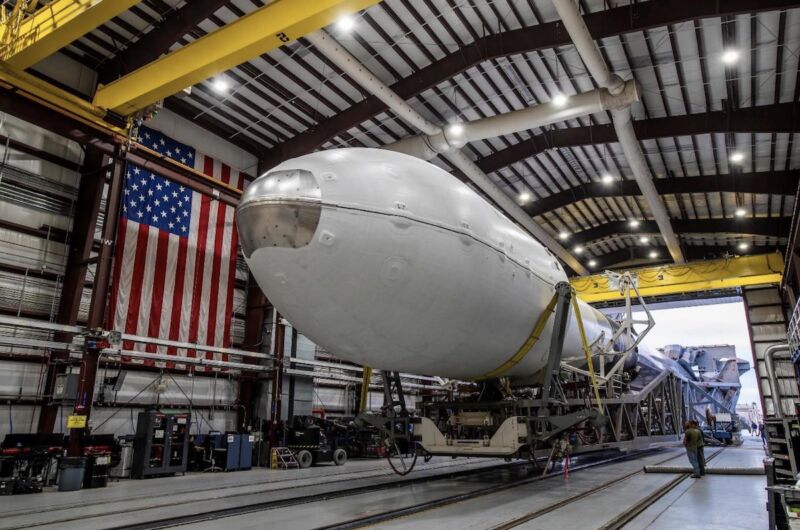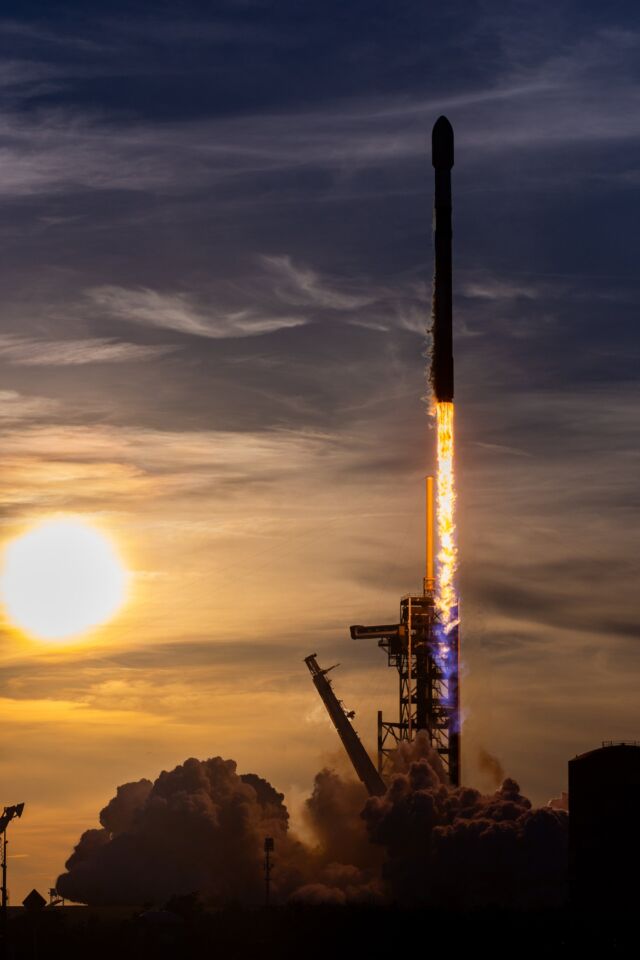
For the first time, SpaceX will launch one of its reusable Falcon 9 boosters for a 20th time Friday night on a flight to deliver 23 more Starlink Internet satellites to orbit.
This milestone mission is scheduled to lift off at 9:22 pm EDT Friday (01:22 UTC Saturday) from Space Launch Complex 40 (SLC-40) at Cape Canaveral Space Force Station, Florida. Forecasters from the US Space Force predict “excellent” weather for the primetime launch.
Falcon 9 will blaze a familiar trail into space, following the same profile as dozens of past Starlink missions.
The rocket’s first-stage booster will shut off its nine kerosene-fueled Merlin engines about two-and-a-half minutes into the flight, reaching a top speed of more than 5,000 mph (8,000 km per hour). The first stage will detach from the Falcon 9’s upper stage, which will continue firing into orbit. The 15-story-tall Falcon 9 booster, meanwhile, will follow an arcing trajectory before braking for a vertical landing on a drone ship floating in the Atlantic Ocean near the Bahamas.
The 23 flat-packed Starlink spacecraft will deploy from the upper stage a little more than an hour after liftoff, bringing the total number of Starlinks in low-Earth orbit to more than 5,800 spacecraft.
A hunger for launch
Pretty much every day, SpaceX is either launching a rocket or rolling one out of the hangar to the launch pad. At this pace, SpaceX is redefining what is routine in the space industry, but the rapid-fire launch rate also means the company is continually breaking records, mostly its own.
Friday night’s launch will break another one of those records. This first-stage booster, designated by the tail number B1062, has flown 19 times since its first flight in November 2020. The booster will now be the first in SpaceX’s inventory to go for a 20th flight, breaking a tie with three other rockets as the company’s fleet-leader.
When SpaceX debuted the latest version of its Falcon 9 rocket, the Falcon 9 Block 5, officials said the reusable first stage could fly 10 times with minimal refurbishment, and perhaps additional flights with a more extensive overhaul. Now, SpaceX is certifying Falcon 9 boosters for 40 flights.
This particular rocket has not undergone any extended maintenance or long-term grounding. It has flown an average of once every two months since debuting three-and-a-half years ago. So the 20-flight milestone SpaceX will achieve Friday night means this rocket has doubled its original design life, and at the same time, has reached the halfway point of its extended service life.
In its career, this booster has launched eight people and 530 spacecraft, mostly Starlinks. The rocket’s first two flights launched GPS navigation satellites for the US military, then it launched two commercial human spaceflight missions with Dragon crew capsules. These were the all-private Inspiration4 mission and Axiom Mission 1, the first fully commercial crew flight to the International Space Station.

Remarkably, this will be the sixth Falcon 9 launch in less than eight days, more flights than SpaceX’s main US rival, United Launch Alliance, has launched in 17 months.
It will be the 38th Falcon 9 launch of the year, and the 111th flight of a Falcon 9 or Falcon Heavy rocket—the 114th launch by SpaceX overall—in the last 365 days. More than a third of all of SpaceX’s Falcon 9 or Falcon Heavy missions, a number that will stand at 332 after Friday night’s flight, have launched in the past year.
This month, for the first time, SpaceX demonstrated it can launch two Falcon 9 rockets in less than five days from the company’s launch pad at Vandenberg Space Force Base, California. SpaceX has also cut the turnaround time between Falcon 9 rockets at Launch Complex 39A at NASA’s Kennedy Space Center. The company’s most-used launch pad, SLC-40, can handle two Falcon 9 flights in less than four days.
It’s not just launch pad turnaround. SpaceX uses its drone ships—two based in Florida and one in California—for most Falcon 9 landings. In order to meet the appetite for Falcon 9 launches, SpaceX is getting rockets back to port and re-deploying drone ships back to sea at a faster rate.


















+ There are no comments
Add yours